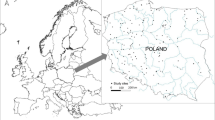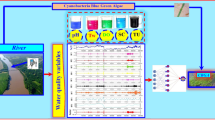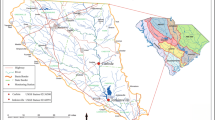Abstract
Algal atypical proliferation is a consequence of water fertilization (also called eutrophication) and a worldwide environmental concern since water quality and its uses are seriously compromised. Prevention is the most effective measure given that once the algal proliferation starts, it is too difficult and costly to stop the process. This article presents a nonparametric machine learning algorithm that combines the gradient boosted regression tree (GBRT) model and an improved differential evolution algorithm (L-SHADE) for better understanding and control of the algal abnormal proliferation (usually estimated from Chlorophyll-a and Total Phosphorus concentrations) from physicochemical and biological variable values obtained in a northern Spain reservoir. This L-SHADE technique involves the optimization of the GBRT hyperparameters during the training process. Apart from successfully estimating algal atypical growth (coefficients of determination equal to 0.91 and 0.93 for Chlorophyll-a and Total Phosphorus concentrations were obtained, respectively), this hybrid model allows here to establish the ranking of each independent biological and physicochemical variable according to its importance in the algal enhanced growth.









Similar content being viewed by others
Explore related subjects
Discover the latest articles, news and stories from top researchers in related subjects.References
Alexandrov MH, Bloesch J (2009) Eutrophication of lake Tasaul, Romania—proposals for rehabilitation. Environ Sci Pollut R 16(1):42–45
Grundy RD (1971) Strategies for control of man-made eutrophication. Environ Sci Tech 5:1184–1190
Reynolds CS (2006) Ecology of phytoplankton. Cambridge University Press, New York
Xue X, Landis A (2010) Eutrophication potential of food consumption patterns. Environ Sci Technol 44:6450–6456
Smith VH (1983) Low nitrogen to phosphorus ratios favor dominance by blue-green algae in Lake Phytoplankton. Science 221(4611):669–671
Álvarez Cobelas M, Arauzo M (2006) Phytoplankton responses to varying time scales in a eutrophic reservoir. Arch Hydrobiol Ergebn Limnol 40:69–80
Liu Y, Guo H, Yu Y, Dai Y, Zhou F (2008) Ecological–economic modeling as a tool for watershed management: a case study of Lake Qionghai watershed, China. Limnologica 38(2):89–104
Takaara T, Sano D, Masago Y, Omura T (2010) Surface–retained organica matter of Microcystis aeruginosa inhibiting coagulation with polyaluminum chloride in drinking water treatment. Water Res 44:3781–3786
Texeira MR, Rosa MJ (2006) Comparing disolved air flotation and conventional sedimentation to remove cyanobacterial cells of Microcystis aeruginosa: part I: the key operating conditions. Sep Purif Technol 52:84–94
Gibson G, Carlson R, Simpson J, Smelzer E (2000) Nutrient criteria technical guidance manual: lakes and reservoirs. In: EPA-822-B-00-001, United States Environment Protection Agency (USEPA), Office of Water, Washington DC, USA
Karydis M (2009) Eutrophication assessment of coastal waters based on indicators: a literature review. Global NEST J 11:373–390
Spatharis S, Tsirtsis G (2010) Ecological quality scales based on phytoplankton for the implementation of Water Framework Directive in Eastern Mediterranean. Ecol Indic 10(4):840–847
Borja A, Dauer DM (2008) Assessing the environmental quality status in estuarine and coastal systems: comparing methodologies and indices. Ecol Indic 8:331–337
Directive 2000/60/EC of the European Parliament and of the Council of 23 October 2000. Establishing a framework for community action in the field of water policy, L-327, Luxembourg
Hillebrand H, Dürselen C-D, Kirschtel D, Pollinger U, Zohary T (1999) Biovolume calculation for pelagic and benthic microalgae. J Phycol 35:403–424
Wang S, Jin X, Bu Q, Jiao L, Wu F (2008) Effects of dissolved oxygen supply level on phosphorus release from lake sediments. Colloid Surf A 316:245–252
Kitsiou D, Karydis M (2011) Coastal marine eutrophication assessment: a review on data analysis. Environ Int 37:778–801
Karlson K, Rosenberg R, Bonsdorff E (2002) Temporal and spatial large-scale effects of eutrophication and oxygen deficiency on benthic fauna in Scandinavian waters–a review. Oceanogr Mar Biol Ann Rev 40:427–489
Charpa SC (1997) Surface water-quality modelling. McGraw-Hill, New York
Díaz RJ, Rosenberg R (2011) Introduction to environmental and economic consequences of hypoxia. Int J Water Resour Dev 27:71–82
Chibole OK (2013) Modeling River Sosiani’s water quality to assess human impact on water resources at the catchment scale. Ecohydrol Hydrobiol 13:241–245
Wu G, Xu Z (2011) Prediction of algal blooming using EFDC model: case study in the Daoxiang Lake. Ecol Modell 222:1245–1252
Dogan E, Sengorur B, Koklu R (2009) Modeling biological oxygen demand of the Melen River in Turkey using an artificial neural network technique. J Environ Manag 90:1229–1235
Singh KP, Basant A, Malik A, Jain G (2009) Artificial neural network modeling of the river water quality—a case study. Ecol Modell 220:888–895
Hastie T, Tibshirani R, Friedman J (2016) The elements of statistical learning. Springer, New York
Breiman L, Friedman J, Olshen R, Stone C (1984) Classification and regression trees. Wadsworth and Brooks, Monterrey
Friedman JH (2002) Stochastic gradient boosting. Comput Stat Data An 38(4):367–378
Schapire RE (2003) The boosting approach to machine learning an overview. In: Denison DD, Hansen MH, Holmes CC, Mallick B, Yu B (eds) Nonlinear estimation and classification, Lecture notes in statistics, Springer, Germany, vol 171, pp 149–171
Bühlmann P, Hothorn T (2007) Boosting algorithms: regularization, prediction and model fitting. Stat Sci 22(4):477–505
Feoktistov V (2006) Differential evolution: in search of solutions. Springer, New York
Price K, Storn RM, Lampinen JA (2005) Differential evolution: a practical approach to global optimization. Springer, Berlin
Rocca P, Oliveri G, Massa A (2011) Differential evolution as applied to electromagnetics. IEEE Antennas Propag 53(1):38–49
Storn R, Price K (1997) Differential evolution—a simple and efficient heuristic for global optimization over continuous spaces. J Global Optim 11:341–359
Landry M, Erlinger TP, Patschke D, Varrichio C (2016) Probabilistic gradient boosting machines for GEFCom2014 wind forecasting. Int J Forecasting 32(3):1061–1066
Persson C, Bacher P, Shiga T, Madsen H (2017) Multi-site solar power forecasting using gradient boosted regression trees. Sol Energy 150:423–436
Johnson NE, Ianiuk O, Cazap D, Liu L, Starobin D, Dobler G, Ghandehari M (2017) Patterns of waste generation: a gradient boosting model for short-term waste prediction in New York City. Waste Manage 62:3–11
Xiong D, Gui Q, Hou W, Ding M (2018) Gradient boosting for single image super-resolution. Inf Sci 454–455:328–343
Lu H, Wang H, Yoon SW (2019) A dynamic gradient boosting machine using genetic optimizer for practical breast cancer prognosis. Expert Syst Applic 116:340–350
Chen Z-Y, Zhang T-H, Zhang R, Zhu Z-M, Yang J, Cheng P-Y, Ou C-Q, Guo Y (2019) Extreme gradient boosting model to estimate PM2.5 concentrations with missing-filled satellite data in China. Atmos Environ 202:180–189
Liu B, Yan S, You H, Dong Y, Li Y, Lang J, Gu R (2018) Road surface temperature prediction based on gradient extreme learning machine boosting. Comput Ind 99:294–302
Simon D (2013) Evolutionary optimization algorithms. Wiley, New York
Yang X-S, Cui Z, Xiao R, Gandomi AH, Karamanoglu M (2013) Swarm intelligence and bio-inspired computation: theory and applications. Elsevier, London
Fister I, Stranad D, Yang X-S, Fister I Jr. (2015) Adaptation and hybridization in nature-inspired algorithms. In: Fister I, Fister I Jr. (eds) Adaptation and hybridization in computational intelligence, vol 18. Springer, New York, pp 3–50
Fogg GE, Stewart WDP, Fay P, Walsby AE (1973) The blue-green algae. Academic Press, London
Smith MJ, Shaw GR, Eaglesham GK, Ho L, Brookes JD (2008) Elucidating the factors influencing the biodegradation of cylindrospermopsin in drinking water sources. Environ Toxicol 23:413–421
World Health Organization (1998) Guidelines for drinking-water quality: health criteria and other supporting information, vol 2, Geneva, World Health 408 Organization
Willame R, Jurckzak T, Iffly JF, Kull T, Meriluoto J, Hoffman L (2005) Distribution of hepatotoxic cyanobacterial blooms in Belgium and Luxembourg. Hydrobiologia 551:99–117
Brönmark C, Hansson L-A (2005) The biology of lakes and ponds. Oxford University Press, New York
Quesada A, Moreno E, Carrasco D, Paniagua T, Wormer L, de Hoyos C, Sukenik A (2006) Toxicity of Aphanizomenon ovalisporum (Cyanobacteria) in a Spanish water reservoir. Eur J Phycol 41:39–45
Negro AI, de Hoyos C, Vega JC (2000) Phytoplankton structure and dynamics in Lake Sanabria and Valparaíso reservoir (NW Spain). Hydrobiologia 424:25–37
American Public Health Association, American Water Works Association, Water Environment Federation (2005) Standard Methods for the Examination of Water and Wastewater, no. 21. APHA/AWWA/WEF, Washington
France RL, Peters RH (1995) Predictive model of the effects on Lake Metabolism of decreased airborne litter fall through riparian deforestation. Conserv Biol 9(6):1578–1586
Nicholls KH, Steedman RJ, Carey EC (2003) Changes in phytoplankton communities following logging in the drainage basins of three boreal forest lakes in north-western Ontario. Can J Fish Aquat Sci 60:43–54
Friedman JH, Hastie T, Tibshirani R (2000) Additive logistic regression: a statistical view of boosting. Ann Stat 28(2):337–407
Friedman JH (2001) Greedy function approximation: a gradient boosting machine. Ann Stat 29(5):1189–1232
Mayr A, Binder H, Gefeller O, Schmid M (2014) The evolution of boosting algorithms: from machine learning to statistical modelling. Method Inform Med 6(1):419–427
Mayr A, Binder H, Gefeller O, Schmid M (2014) Extending statistical boosting: an overview of recent methodological developments. Method Inform Med 6(2):428–435
Taieb SB, Hyndman RJ (2014) A gradient boosting approach to the kaggle load forecasting competition. Int J Forecasting 30(2):382–394
Döpke J, Fritsche U, Pierdzioch C (2017) Predicting recessions with boosted regression trees. Int J Forecasting 33:745–759
Ridgeway G (2007) Generalized boosted models: a guide to the GBM package. http://www.saedsayad.com/docs/gbm2.pdf. Accessed 3 August 2007
Chen T, Guestrin C (2016) XGBoost: a scalable tree boosting system. In: Proceedings of the 22nd ACM SIGKDD International Conference on Knowledge Discovery and Data Mining, ACM, San Francisco, California, USA, pp 785–794
Brest J, Maucec MS, Boskovic B (2017) Single objective real-parameter optimization: Algorithm jSO. In: Proceedings of the 2017 IEEE Congress on Evolutionary Computation, IEEE Publisher, Donostia-San Sebastián, Spain, pp 1311–1318
Brest J, Maucec MS, Boskovic B (2016) iL-SHADE: Improved L-SHADE algorithm for single objective real-parameter optimization. In: Proceedings of the 2016 IEEE Congress on Evolutionary Computation, IEEE Publisher, Vancouver, BC, Canada, pp 1188–1195
Tanabe R, Fukunaga AS (2013) Evaluating the performance of SHADE on CEC 2013 benchmark problems. In: Proceedings of the 2013 IEEE Congress on Evolutionary Computation, IEEE Publisher, Cancun, Mexico, pp 1952–1959
Qin AK, Huang VL, Suganthan PN (2009) Differential evolution algorithm with strategy adaptation for global numerical optimization. IEEE T Evolut Comput 13(2):398–417
Zhang J, Sanderson AC (2009) JADE: adaptive differential evolution with optional external archive. IEEE T Evolut Comput 13(5):945–958
Tanabe R, Fukunaga AS (2014) Improving the search performance of SHADE using linear population size reduction. In: Proceedings of the 2014 IEEE Congress on Evolutionary Computation (CEC), IEEE Publisher, Beijing, China, pp 1658–1665
Wu G, Mallipeddi R, Suganthan PN, Wang R, Chen H (2016) Differential evolution with multi-population based ensemble of mutation strategies. Inform Sci 329:329–345
Allman ES, Rhodes JA (2003) Mathematical models in biology: an introduction. Cambridge University Press, New York
Barnes DJ, Chu D (2010) Introduction to modeling for biosciences. Springer, New York
Freedman D, Pisani R, Purves R (2007) Statistics. W.W. Norton & Company, New York
Wasserman L (2003) All of statistics: a concise course in statistical inference. Springer, New York
Bishop CM (2011) Pattern recognition and machine learning. Springer, Berlin
Berk RA (2016) Statistical learning from a regression perspective. Springer, Berlin
Picard R, Cook D (1984) Cross-validation of regression models. J Am Stat Assoc 79(387):575–583
Criado Ramón D (2017) PyADE: Multiple differential evolution algorithms. https://github.com/xKuZz/pyade. Accessed 23 October 2017
Chorus I, Bartram J (1999) Toxic cyanobacteria in water: a guide to their public health consequences, monitoring and management. E & FN Spon, London
Aboal M, Puig MA (2005) Intracellular and dissolved microcystins in reservoirs of the river Segura basin, Murcia, SE Spain. Toxicon 45(4):509–518
Gault PM, Marler HJ (2009) Handbook on Cyanobacteria: biochemistry, biotechnology and applications. Nova Science Publishers, New York
Dow CS, Swoboda UK (2000) Cyanotoxins. In: Whitton BA, Potts M (eds) The ecology of Cyanobacteria: their diversity in time and space. Kluwer Academic Publishers, Dordrecht, pp 613–632
Lv J, Wu H, Chen M (2011) Effects of nitrogen and phosphorus on phytoplankton composition and biomass in 15 subtropical, urban shallow lakes in Wuhan, China. Limnologica 41(1):48–56
Brezonik PL, Menken KD, Bauer ME (2005) Landsat-based remote sensing of lake water quality characteristics, including chlorophyll and colored dissolved organic matter (CDOM). Lake Reserv Manage 21:373–382
Rast W, Thornton JA (2005) Phosphorus loading concept and the OECD eutrophication programme: origin, application and capabilities. In: O’Sullivan P, Reynolds CS (eds) The lakes handbook: lake restoration and rehabilitation, Blackwell Science, Oxford, UK, vol 2, pp 354–385
Gadi VK, Tang Y-R, Das A, Monga C, Garg A, Berretta C, Sahoo L (2017) Spatial and temporal variation of hydraulic conductivity and vegetation growth in green infrastructures using infiltrometer and visual technique. CATENA 155:20–29
Redden AM, Rukminasari N (2008) Effects of increases in salinity on phytoplankton in the Broadwater of the Myall lakes, NSW, Australia. Hydrobiologia 608:87–97
Schindler DW, Hecky RE, Findlay DL, Stainton MP, Parker BR, Paterson MJ, Beaty KG, Lyng M, Kasian SEM (2008) Eutrophication of lakes cannot be controlled by reducing nitrogen input: results of a 37-year whole-ecosystem experiment. P Natl Acad Sci USA 105(32):11254–11258
Bužančić M, Gladan ŽN, Marasović I, Kušpilić G, Grbec B (2016) Eutrophication influence on phytoplankton community composition in three bays on the eastern Adriatic coast. Oceanologia 58(4):302–316
Watson SB, Whitton BA, Higgins SN, Paerl HW, Brooks BW, Wehr JD (2015) Harmful algal blooms. In: Wehr J, Sheath R, Kociolek JP (eds) Aquatic ecology, freshwater algae of North America, Academic Press, Cambridge, Massachusetts, USA, chpt 20, pp 873–920
Dagenais-Bellefeuille S, Morse D (2013) Putting the N in dinoflagellates. Front Microbiol 4(369):1–14
Taylor FJR (1976) Dinoflagellates from the International Indian Ocean Expedition. Biblioth Bot 132:1–234
Rissik D, van Senden D, Doherty M, Ingleton T, Ajani P, Bowling L, Gibbs M, Gladstone M, Kobayashi T, Suthers I, Froneman W (2009) Plankton-related environmental and water-quality issues. In: Suthers IM, Rissik D (eds) Plankton: a guide to their ecology and monitoring for water quality, CSIRO Publishing, Melbourne, Australia, chpt 3, pp 39–72
Ortega-Mayagoitia E, Rojo C (2000) Fitoplancton del Parque Nacional Las Tablas de Daimiel. III. Diatomeas y clorofitas. Anal Jardin Bot Mad 58(1):17–37
Pérez-Martínez C, Sánchez-Castillo P (2004) Temporal occurrence of Ceratium hirundinella in Spanish reservoirs. Hydrobiologia 452:101–107
Bogard MJ, Vogt RJ, Haye NM, Leavitt PR (2020) Unabated nitrogen pollution favors growth of toxic Cyanobacteria over Chlorophytes in most hypereutrophic lakes. Environ Sci Technol 54(6):3219–3227
Arend KK, Betelsky D, DePinto JV, Ludsin SA, Roberts JJ, Rucinski DK, Scavia D, Schwab DJ, Hook TO (2011) Seasonal and interannual effects of hypoxia on fish habitat quality in central Lake Erie. Freshwater Biol 56:366–383
Huang Y, Chen M (2013) Variation of dissolved oxygen in the experiments of occurrence & disappearance for Microcystis bloom. Procedia Environ Sci 18:559–566
Fields S (2004) Global nitrogen: cycling out of control. Environ Health Persp 112(10):A556–A563
Zhan X, Bo Y, Zhou F, Liu X, Paerl HW, Shen J, Wang R, Li F, Tao S, Dong Y, Tang X (2017) Evidence for the importance of atmospheric nitrogen deposition to eutrophic lake Dianchi, China. Environ Sci Technol 51(12):6699–6708
Zeeb BA, Christie CE, Smol JP, Findlay DL, Kling HJ, Birks HJB (1994) Responses of diatom and Chrysophyte assemblages in Lake 227 sediments to experimental eutrophication. Can J Fish Aquat Sci 51(10):2300–2311
Ortega-Mayagoitia E, Rojo C (1999) Phytoplankton from the Daimiel National. Park II. Cyanophytes, dinoflagellates, cryptophytes, chrysophytes and xanthophytes. Anal Jardín Bot Mad 57(2):251–266
Bronk DA, See JH, Bradley P, Killberg L (2007) DON as a source of bioavailable nitrogen for phytoplankton. Biogeosciences 4:283–296
Schilling KE, Kim S-W, Jones CS (2017) Use of water quality surrogates to estimate total phosphorus concentrations in Iowa rivers. J Hydrol Reg Stud 12:111–121
Lannergård EE, Ledesma JLJ, Fölster J, Futter MN (2019) An evaluation of high frequency turbidity as a proxy for riverine total phosphorus concentrations. Sci Total Environ 651(1):103–113
Villa A, Fölster J, Kyllmar K (2019) Determining suspended solids and total phosphorus from turbidity: comparison of high-frequency sampling with conventional monitoring methods. Environ Monit Assess 191(10):605–620
Correll DL (1999) Phosphorus: a rate limiting nutrient in surface waters. Poultry Sci 78(5):674–682
Schindler DW, Carpenter SR, Chapra SC, Hecky RE, Orihel DM (2016) Reducing phosphorus to Curb lake eutrophication is a success. Environ Sci Technol 50(17):8923–8929
Lambou VW, Hern SC, Taylor WD, Williams LR (1982) Chlorophyll, phosphorus, Secchi disk, and trophic state. J Am Water Resour As 18(5):807–813
Brezonik PL (1978) Effect of organic color and turbidity of Secchi disk transparency. J Fish Res Board Can 35(11):1410–1416
Stehlík M, Dušek J, Kiseľák J (2016) Missing chaos in global climate change data interpreting? Ecol Complex 25:53–59
Acknowledgements
The authors wish to thank the Cantabrian Basin Authority (Spanish Ministry of Agriculture, Food and Environment) for providing the experimental dataset used in this research. Additionally, we would like to thank Anthony Ashworth for his revision of English grammar and spelling of the manuscript.
Author information
Authors and Affiliations
Corresponding author
Ethics declarations
Conflict of interest
The authors declare no conflict of interest.
Additional information
Publisher's Note
Springer Nature remains neutral with regard to jurisdictional claims in published maps and institutional affiliations.
Rights and permissions
About this article
Cite this article
García-Nieto, P.J., García-Gonzalo, E., Alonso Fernández, J.R. et al. Modeling algal atypical proliferation in La Barca reservoir using L-SHADE optimized gradient boosted regression trees: a case study. Neural Comput & Applic 33, 7821–7838 (2021). https://doi.org/10.1007/s00521-020-05523-0
Received:
Accepted:
Published:
Issue Date:
DOI: https://doi.org/10.1007/s00521-020-05523-0




